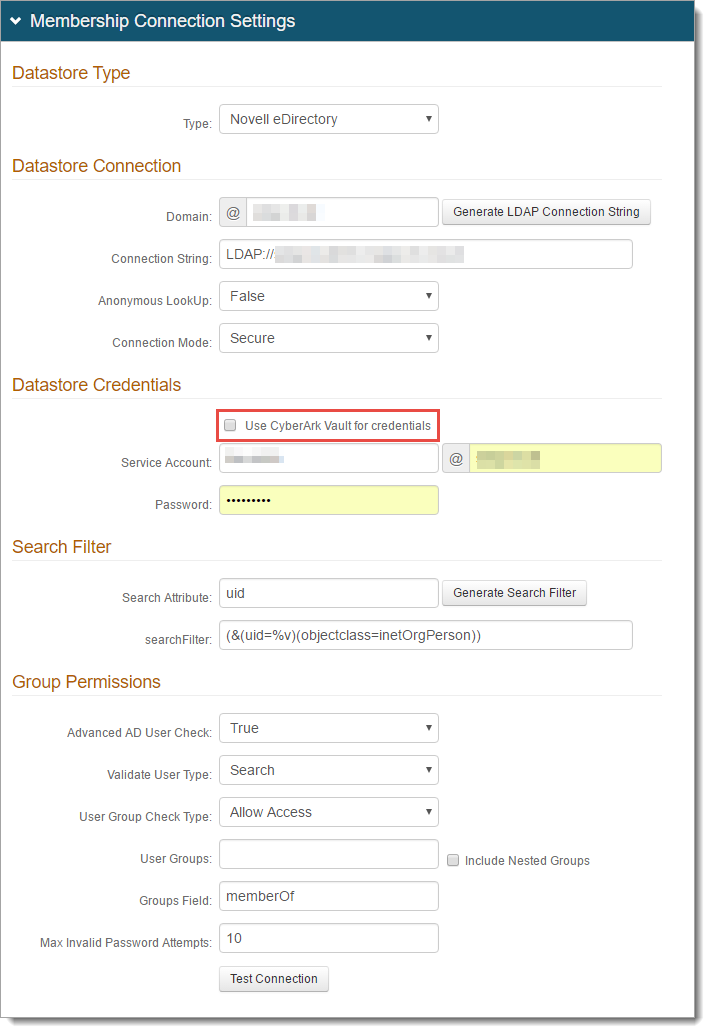NetIQ eDirectory configuration
Use this guide along with the Data Tab Configuration guide to configure and integrate a NetIQ (formerly Novell) eDirectory in a SecureAuth® Identity Platform (formerly SecureAuth IdP) realm.
Prerequisites
Identity Platform version 19.07 and earlier
On-premises eDirectory data store
eDirectory service account with read access and optional write access for the Identity Platform
Net IQ eDirectory configuration
In the Classic Experience, go to the Data tab.
In the Membership Connection Settings section, set the following:
Datastore Type
Type
Set to Novell eDirectory.
Datastore Connection
Domain
Set the domain of the Active Directory.
Connection String
Click Generate LDAP Connection String to automatically populate this field.
Anonymus LookUp
Choose from the following values:
True – Search the directory without supplying the username.
False – Username must be supplied to search the directory.
Connection Mode
Set the how the Identity Platform and the directory connect. Choose from the following values:
Secure – Enable a secure LDAP connection on Port 389, using NTLMv2.
SSL – Enable a secure connection on Port 636, but uses Secure Socket Layer technology, which relies on certificates.
Standard – Enable a standard LDAP connection on Port 389 that uses basic authentication (plain text).
Datastore Credentials
Use one of the following credentials.
Use CyberArk Vault for Credentials
To use CyberArk Vault, select this check box and follow the steps in CyberArk Password Vault Server and AIM Integration with SecureAuth IdP.
Service Account, Domain, and Password
Provide the username, domain, and password for the service account login.
Search Filter
Do the following:
Provide the Search Attribute used to search for the user account in the directory. For example, uid.
Click Generate Search Filter to automatically populate the searchFilter field.
The value that equals
%vis what the end user provides on the login page, so if it is different from the Search Attribute, change it here.For example, if the Search Attribute is
uid, but end users log in with their email addresses (field=uid), the searchFilter would be(&(uid=%v)(objectclass=inetOrgPerson)).
Search Attribute
To search for the user account in the directory, provide the search attribute. For example,
uid.searchFilter
Click Generate Search Filter to automatically populate this field.
The value that equals
%vis what the end user provides on the login page, so if it is different from the Search Attribute, change it here.For example, if the Search Attribute is
uid, but end users log in with their email addresses (field= mail), the searchFilter would be(&(mail=%v)(objectclass=inetOrgPerson)).Group Permissions
Advanced AD User Check
To check the directory for more user information, set to True.
This is useful in a scenario in which a user account is locked.
Validate User Type
Choose how to validate usernames and passwords in the directory:
Bind – Make a direct call to the directory to validate the username and password
Search – Use the search function to find and validate a username and password
User Group Check Type
To allow or restrict group access to the realm, choose Allow Access or Deny Access. provide a list of Allowed Groups and Denied Groups in a comma delimited format.
User Groups
If there is no access restriction, leave blank. Otherwise, provide a list of groups allowed or denied access. For example, admins.
Groups Field
Provide the groups field containing the user groups. For example, memberOf.
Max Invalid Password Attempts
Set the maximum number failed password attempts by the user before the account is locked.

Click Test Connection to ensure that the integration is successful.
Next steps
Complete the Data Tab Configuration in the Identity Platform.